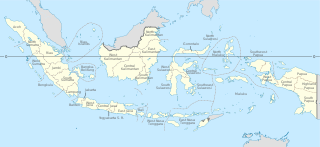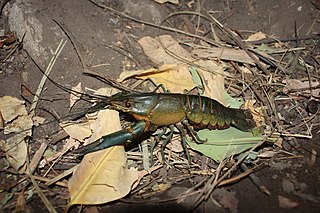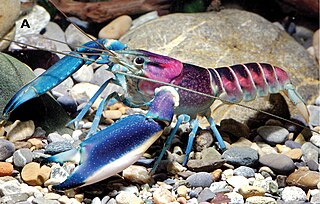
Crayfish are freshwater crustaceans belonging to the clade Astacidea, which also contains lobsters. In some locations, they are also known as baybugs, crabfish, craws, crawfish, crawdaddies, crawdads, freshwater lobsters, mountain lobsters, mudbugs, rock lobsters, signal crawfish, or yabbies. Taxonomically, they are members of the superfamilies Astacoidea and Parastacoidea. They breathe through feather-like gills. Some species are found in brooks and streams, where fresh water is running, while others thrive in swamps, ditches, and paddy fields. Most crayfish cannot tolerate polluted water, although some species, such as Procambarus clarkii, are hardier. Crayfish feed on animals and plants, either living or decomposing, and detritus.

Provinces of Indonesia are the 38 administrative divisions of Indonesia and the highest tier of the local government. Provinces are further divided into regencies and cities, which are in turn subdivided into districts (kecamatan).

The Parastacidae are the family of freshwater crayfish found in the Southern Hemisphere. The family is a classic Gondwana-distributed taxon, with extant members in South America, Madagascar, Australia, New Zealand, and New Guinea, and extinct taxa also in Antarctica.

Cherax, commonly known as yabby/yabbies in Australia, is the most widespread genus of fully aquatic crayfish in the Southern Hemisphere. Various species of cherax may be found in both still and flowing bodies of freshwater across most of Australia and New Guinea. Together with Euastacus, it is also the largest crayfish genus in the Southern Hemisphere.

Cherax quadricarinatus is an Australian freshwater crayfish.

The common yabby is an Australian freshwater crustacean in the Parastacidae family. It is listed as a vulnerable species of crayfish by the International Union for Conservation of Nature (IUCN), though the wild yabby populations remain strong, and have expanded into new habitats created by reservoirs and farm dams.
Cherax quinquecarinatus is a small freshwater crayfish endemic to the south-west corner of Australia. It is one of two species known as gilgie, or jilgi, which is a seasonal food source for people of the region. Gilgies are found throughout a biogeographically isolated region of the coastal south of Western Australia and are significant in the ecology of aquatic systems of that bioregion.

Lake Kutubu is the second-largest lake in Papua New Guinea, after Lake Murray, and, at 800 m above sea level, the largest upland body of water, with an area of 49.24 km², and a total catchment area of 250 km². Lake Kutubu and Lake Sentani form an ecoregion on the WWF's Global 200. Kutubu lies in the Southern Highlands Province of Papua New Guinea, east of the Kikori River into which it drains, and about 50 km southwest of Mendi, the provincial capital. It is one of the few lakes in the country that occurs in a depression in the rugged interior mountains. The lake has a few islands, the largest of which is Wasemi in its northern part. The water of Lake Kutubu, fed by several streams originating mostly from underground sources, is clear and reaches a depth of 70 m (230 feet). The catchment is inhabited by two main ethnic groups, the Foe to the south and the Fasu to the north. Thirty-three villages lie in the catchment area, with a total estimated population of 10,885.
Cherax nucifraga is a species of crayfish in the family Parastacidae. It is known only from the type locality – Palm Springs, near Channel Point, Northern Territory, Australia – where the holotype was collected from the stomach of a barramundi. It is listed as data deficient on the IUCN Red List.

The marbled crayfish or Marmorkrebs is a parthenogenetic crayfish that was discovered in the pet trade in Germany in 1995. Marbled crayfish are closely related to the "slough crayfish", Procambarus fallax, which is widely distributed across Florida. No natural populations of marbled crayfish are known. Information provided by one of the original pet traders as to where the marbled crayfish originated was deemed "totally confusing and unreliable". The informal name Marmorkrebs is German for "marbled crayfish".

Faxonius immunis is a species of crayfish in the family Cambaridae. It is native to North America and it is an introduced species in Europe, where it lives along the Upper Rhine. Its common names include calico crayfish and papershell crayfish.
The Ayamaru Lakes are a group of lakes found in the west-central part of the Bird's Head Peninsula in Southwest Papua, Indonesia. The nearest village to the group is Greemakolo. The many villages around the Ayamaru Lakes speak Ayamaru language, a dialect of the Maybrat language.

Cherax holthuisi is a species of crayfish from the Bird's Head Peninsula in New Guinea. It grows to a total length of 81–93 mm (3.2–3.7 in) and is typically pink, orange or yellow in wild specimens. It was described in 2006 after animals circulating in the aquarium trade could not be assigned to any known species.

Crayfish are eaten all over the world. Like other edible crustaceans, only a small portion of the body of a crayfish is edible. In most prepared dishes, such as soups, bisques and étouffées, only the tail portion is served. At crawfish boils or other meals where the entire body of the crayfish is presented, other portions, such as the claw meat, may be eaten.

The eastern swamp crayfish is a species of small freshwater crayfish from coastal New South Wales, Australia. It is distinguished from related species by large genital papilla on the males, large raised postorbital ridges, a laterally compressed carapace, and elongated chelae.

Cherax pulcher is a species of crayfish from West Papua in Indonesia. It is popular as a freshwater aquarium species across Asia, Europe, and North America.

Cherax snowden is a species of crayfish from West Papua in Indonesia. In the wild, they live in freshwater river tributaries. It is popular as a freshwater aquarium pet across Asia, Europe, and North America because of its orange-tipped claws. Specimens were previously misidentified as members of Cherax holthuisi, also from West Papua.

Cherax boesemani is a species of crayfish from West Papua in Indonesia. It is popular as a freshwater aquarium pet across Asia, Europe, and North America.













